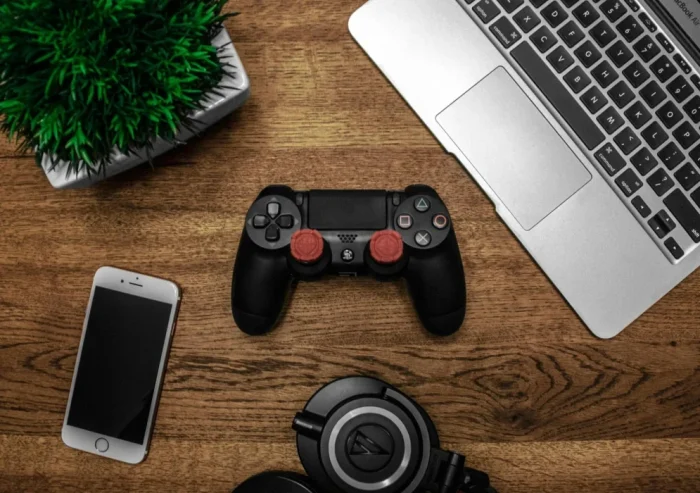Picture this: You’ve just downloaded a gorgeous new mobile game. The visuals are stunning, the controls are slick, and the concept is addictive. You dive in for the first time, and then… You hit mute.
Why? Maybe the soundtrack is a grating, 3-second loop that’s already drilling into your skull. Maybe the sound effects are generic, weightless pops and clinks that feel completely disconnected from the action on screen.
Sound familiar? This is a nightmare scenario for a mobile game app development company. Because that “mute” button isn’t just turning off sound, it’s disconnecting a crucial thread of the player’s emotional experience.
Teams pour their hearts (and budgets) into pixel-perfect art, buttery-smooth code, and clever mechanics, all while treating audio as a final polish, an afterthought. But here’s the inconvenient truth: In the crowded, competitive app stores, incredible audio design isn’t a luxury—it’s a core strategic pillar for any successful mobile game.
So, in this blog, we will guide you through the key principles of using audio to build deeper, more addictive, and more successful games.
The Unseen Game-Changer: More Than Just “Sound”
It is important to know why first before we get down to the how. Audio is misconstrued. It is not an additional layer that is overlaid onto a game that is already finished; it is actually a part of the gameplay loop. The effect of it is immense and manifold:
Emotional Orchestration: Audio is a straight shot to the emotions of a player. An eerie tune may produce tension and mystery. A cheerful and dynamic soundtrack can enhance the euphoria of winning. The absence of sound may lead to discomfort. As the images present the world, the sounds present it to you.
Gameplay Feedback and Information: Sound gives immediate, intuitively oriented feedback. The satisfying “cha-ching!” of gathering coins, the unique swish of a successful swipe, or the rising audio feedback of a time running out, all these sounds are effective communicators of success, failure, and important details, without adding more visual clutter to the screen.
Brand Identity and Memorability: You can think of the famous sound of heads down in Candy Crush or the jingly sound when you start playing Clash of Clans. Such sonic logos come to be associated with the game itself, creating a strong and iconic brand identity that players associate upon seeing it.
The Retention Engine: A soundtrack that is composed well and adapts to the development of the player or the difficulty of the game in question, avoiding auditory fatigue. This subtle variation is key to keeping players engaged during long or repetitive sessions, directly combating churn.
Key Components of Mobile Game Audio Design
We will discuss the key elements that make mobile games sound and how each element makes the game interesting to play.
1. Sound Effects (SFX)
The heartbeat of the interactive gameplay is sound effects. They give immediate feedback to the actions of players, whether it is footsteps and weapon reloads, or clicks of a button and a pickup. Properly designed SFX will keep the players engaged and educated with or without the need to count on visuals.
2. Background Music
Music is not just a background; it is an emotional fuel. Background music in mobile games is the whole experience of tranquility and calmness in puzzle-based games, or a lot of adrenaline and pumping in racing games.
Most contemporary developers have adopted dynamic soundtracks to be used in their games that change tempo and tone depending on the action being performed during the game. The companies that provide music app development services, in most cases, capitalize on such methods and develop systems where audio is perfectly synchronized with user interactions.
3. Voice Acting and Narration
Elements of voice make characters and stories alive. Even brief conversations, the interactions between characters, and cheers could make the gameplay more memorable. In narrative-based games, professional voice acting changes the way the story is told, making it more of an experience rather than a piece of dead text.
4. Ambient Sound
The quiet layer finishing the planet is ambient sound. The realism and depth come from the murmurs of a city street, the whisper of wind across trees, or the distant sound of waves. These sounds guarantee that even still scenes feel immersive by filling the silent gaps between action sequences.
Why Poor Audio Design Hurts Game Performance
Poor or inefficient audio design not only fails to satisfy the players; it sends them away. Now, we can examine more closely why a poor audio design could have a drastic effect on the performance and retention of players of a game.
- Monotonous or disjointed sounds are annoying for a short period of time. The repetition of the same footstep or explosion may even turn an exciting gameplay into a monotony. Gamers desire richness and reality, and recurring sound effects destroy that illusion.
- Lack of audio compatibility, such as the background music obscuring the conversation or important effects, can destroy the atmosphere. A proper balance of the sound layers is also important so that the players can hear what is most important during every phase of the game.
- Inability to give responsive feedback in terms of sound makes the players guess. Sound effects are needed to represent actions, such as hits on successful hits, damage caused, or unlocks. Their absence makes the gameplay sloppy and disorienting.
Technical Challenges in Mobile Game Audio
Audio creation in mobile games is not an easy task, as it requires maintaining a balance between quality, performance, and the user experience within a small space. The following are some of the most common technical challenges that developers can experience:
1. File Size Limitations
The audio files are of high quality, and in mobile gaming, every megabyte counts. The size of the apps can discourage the download or lead to storage problems in the’ gadgets of users. To overcome this, developers will compress files with care or make use of streaming methods to provide an excellent sound without saturating the size of the app.
2. Hardware Differences
Mobile devices do not sound alike. What is perceived as an engaging soundtrack on one smartphone may be perceived as one-dimensional or even puré on a second smartphone. Due to the difference in speakers, processors, and headphones, it is difficult to ensure consistency in audio quality. Creators will have to test sounds in different devices to make it balanced and enjoyable to everyone who will play.
3. Performance Optimization
Audio processing imposes system demands, and too many sound layers or real-time effects can make a game slow or kill the battery. The developers must usually strike the appropriate compromise, balancing performance and, at the same time, ensuring an immersive soundscape.
4. Compression Issues
To be able to compress the files, it must be done at the expense of clarity. Excessive compression may render the sounds small or unnatural. With effective formats such as OGG or MP3, and intelligent compression options, one can retain sound quality and maintain performance at the same time.
Integrating Audio Design into the Development Process
Audio design must not be a by-product but one of the elements of game development. Planned sound is inherently synchronized with visual, gameplay, and storytelling. The following is a way to incorporate it:
- Collaborate Early
Engage sound designers at an early stage. The collaboration at the early stage will make the audio correspond to the tone, pace, and style of the game. It also prevents reworking in the future and makes the whole experience more unified.
- Use Interactive Audio Tools
Development tools such as FMOD and Wwise allow the developer to create adaptive sound systems in response to gameplay events. This interactive style makes the audio exciting and in sync with the movement of the players.
- Test and Tweak in Multiple Environments.
Audit test on other devices, headphones, and volume levels. Mobile hardware is a variable, and such a step will guarantee uniformity and avoid such problems as distorted effects or unbalanced audio.
- Focus on Player Feedback
Sound must not be a distraction. Geometrically get feedback on players to optimize effects, music, and volume balance. Minor modifications on the basis of the specific experience of the user can lead to enormous differences in terms of sustained engagement.
Best Practices for Effective Game Audio Design
To make the experience of your mobile game an excellent one, careful consideration and accuracy in sound design are needed. Exceptional audio does not come on a silver platter; it is a creation of diligent effort and experimentation, and moderation. The following are some of the best practices that can make you do it right:
1. Maintain Audio Consistency
The sound of your game must be in line with the art style and theme of the game. A science-futuristic shooter would require a digital sound, sharp and somewhat metallic, whereas a fantasy adventure would require natural and down-to-earth sound. Coherence assists in the development of a single world in which both the images and sound collaborate to narrate the story.
2. Avoid Audio Overload
When there are too many sounds playing at the same time, it may get overwhelming for the players, making the whole experience fuzzy. Be selective, only emphasize what is necessary. Beautiful layering and timing enable the soundscape to be clear and pleasant, with each cue being meaningful and purposeful.
3. Use Volume Layering
Layering of volume is used to prioritize the important sounds. The fundamental activities, such as attacks, hits, achievements, etc., must be prominently visible, whereas the background music and ambient sounds are rather small. This equilibrium prevents the game from being chaotic.
4. Playtest with Sound
Do not ever test things solely visually; always add audio. Playtesting assists in determining volume problems, repetition loops, or timing problems. Modifying according to these insights will make sure that your sound design does not disrupt the gameplay, but rather improves the gameplay.
Conclusion
When creating mobile games, visuals draw attention, but sound stays. The link between emotion and engagement is audio design, which adds enjoyment to a game that might otherwise be overly simplistic.
Background music sets excitement, sound effects match every movement, and all the right audio preferences can help your game appear and feel the way you want the players to feel.
To create an indie puzzle game or a huge RPG, though, always keep in mind that success is not only visible, but heard.







